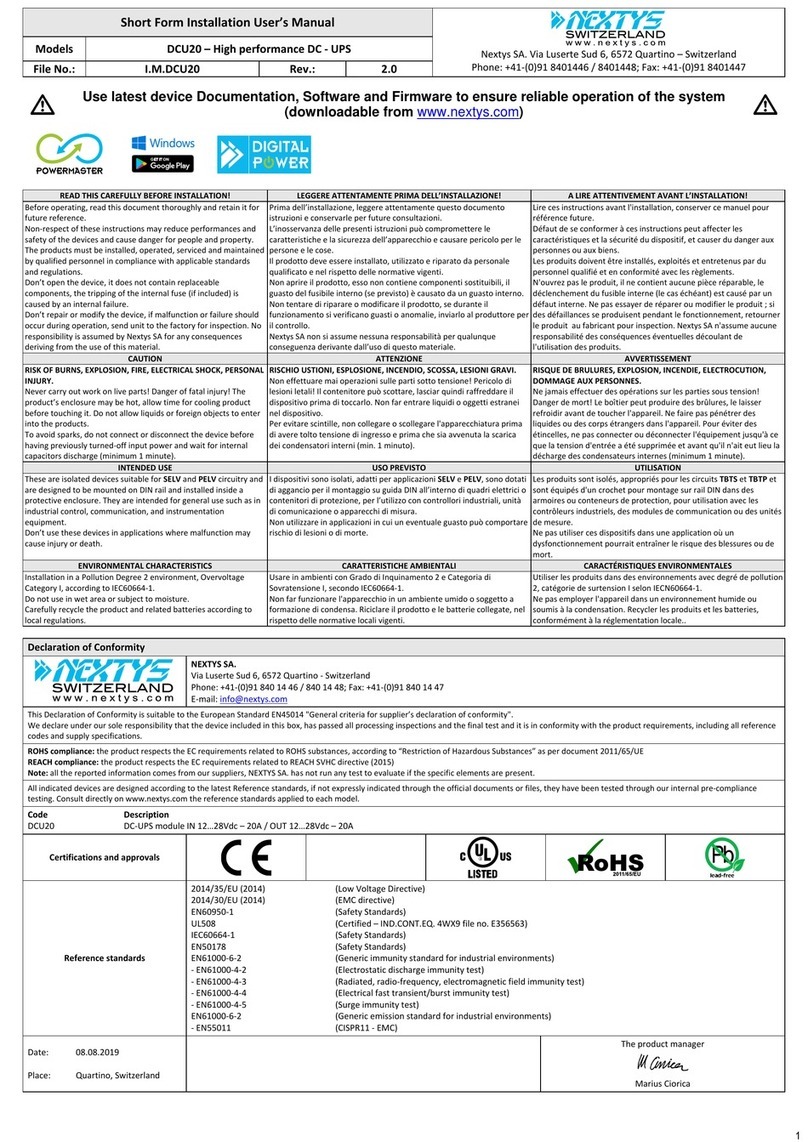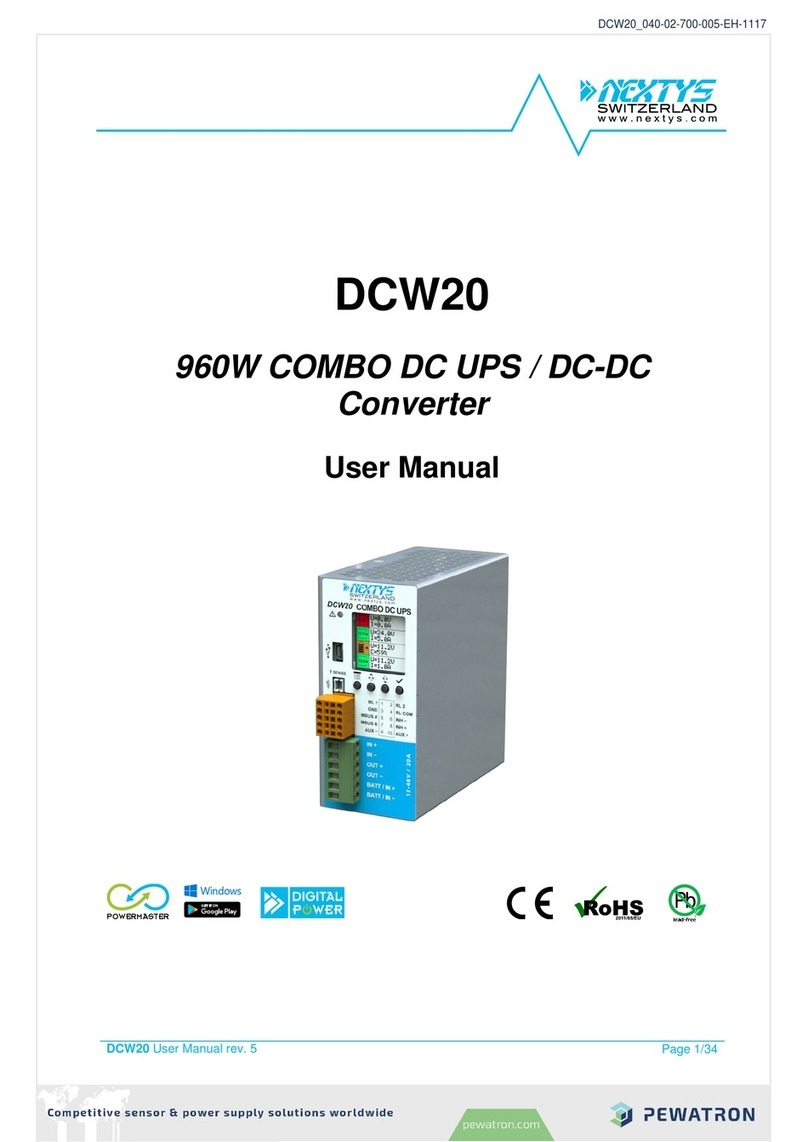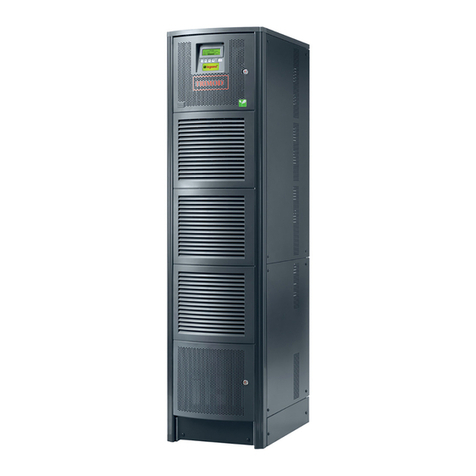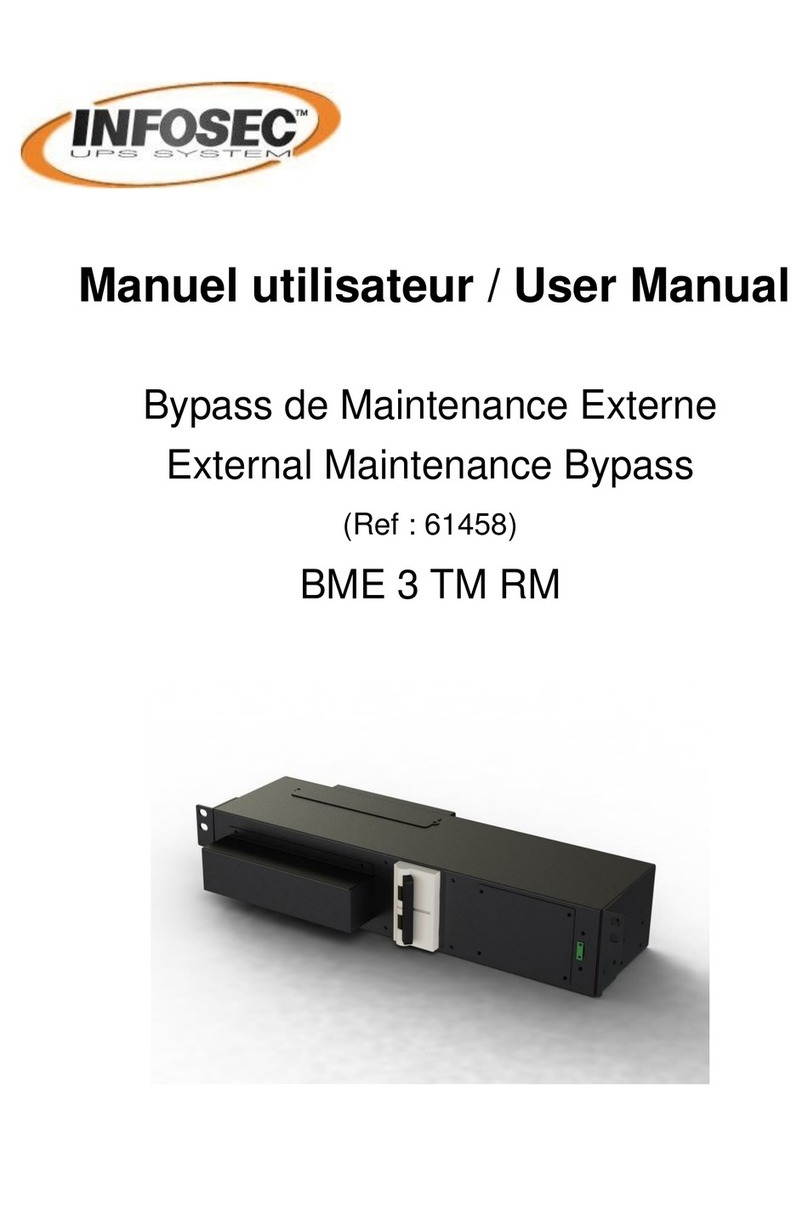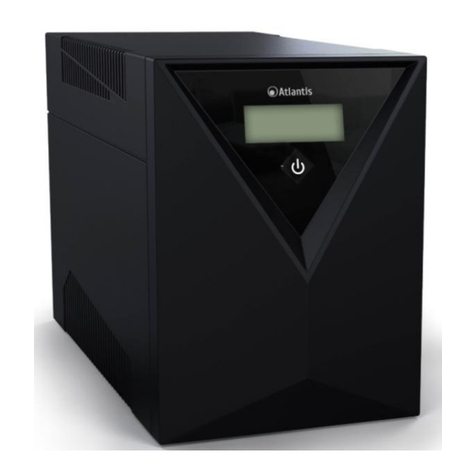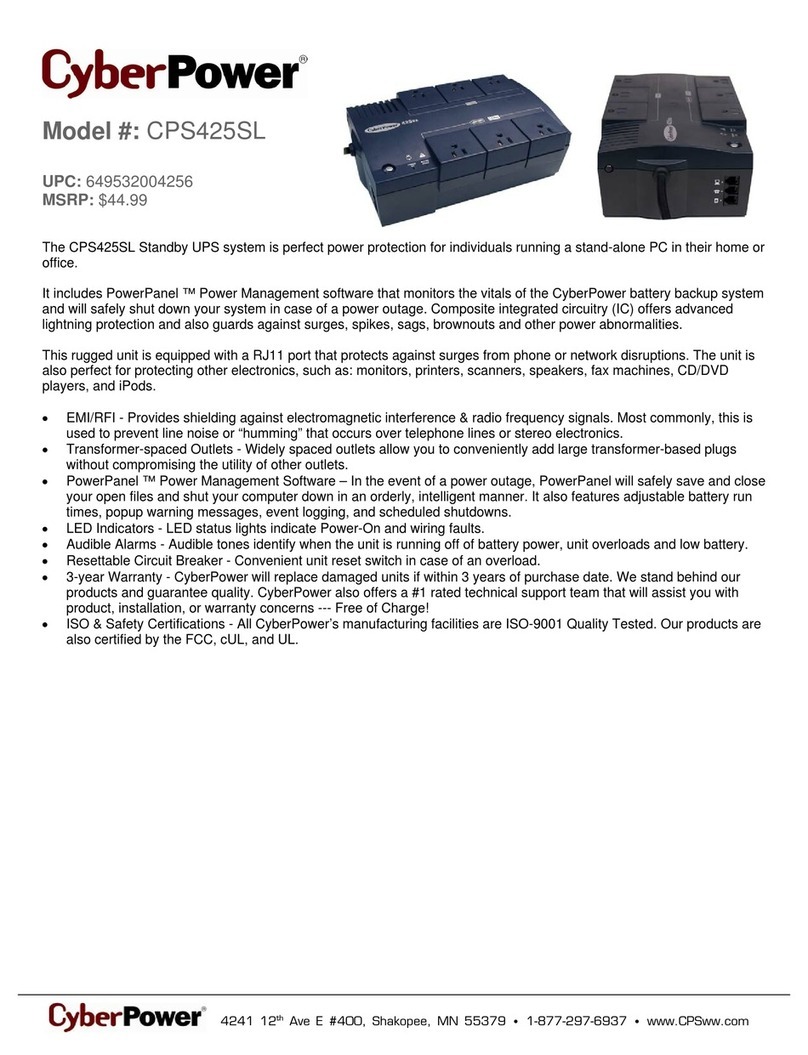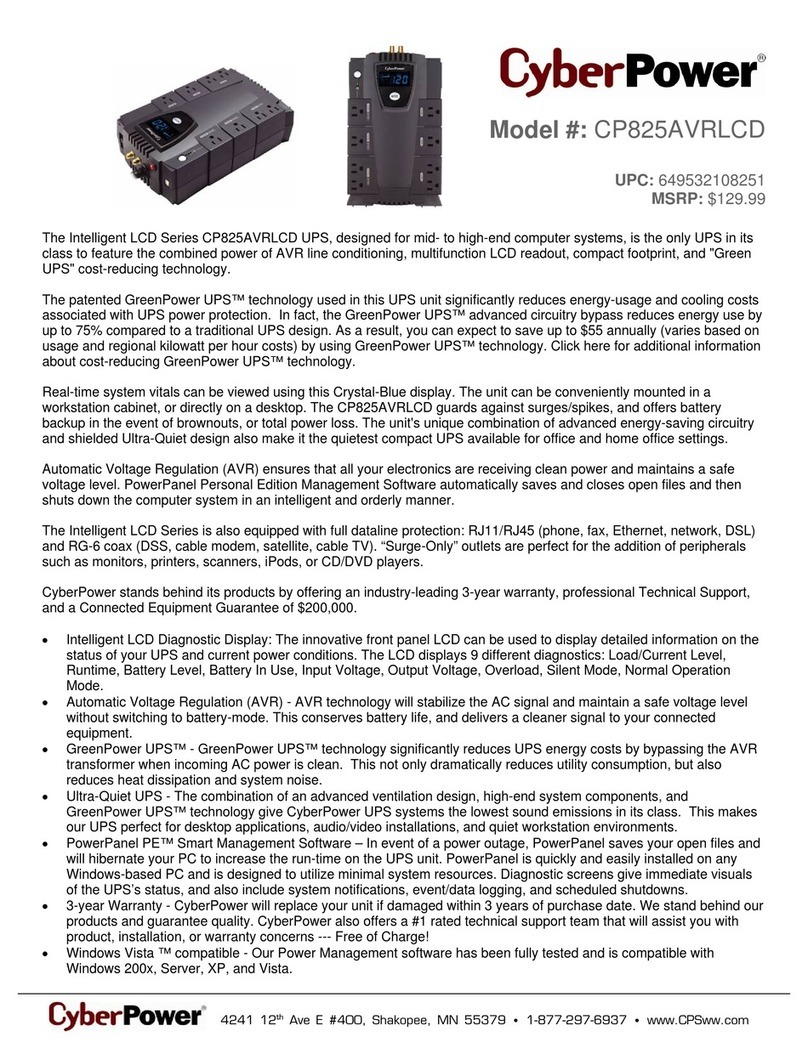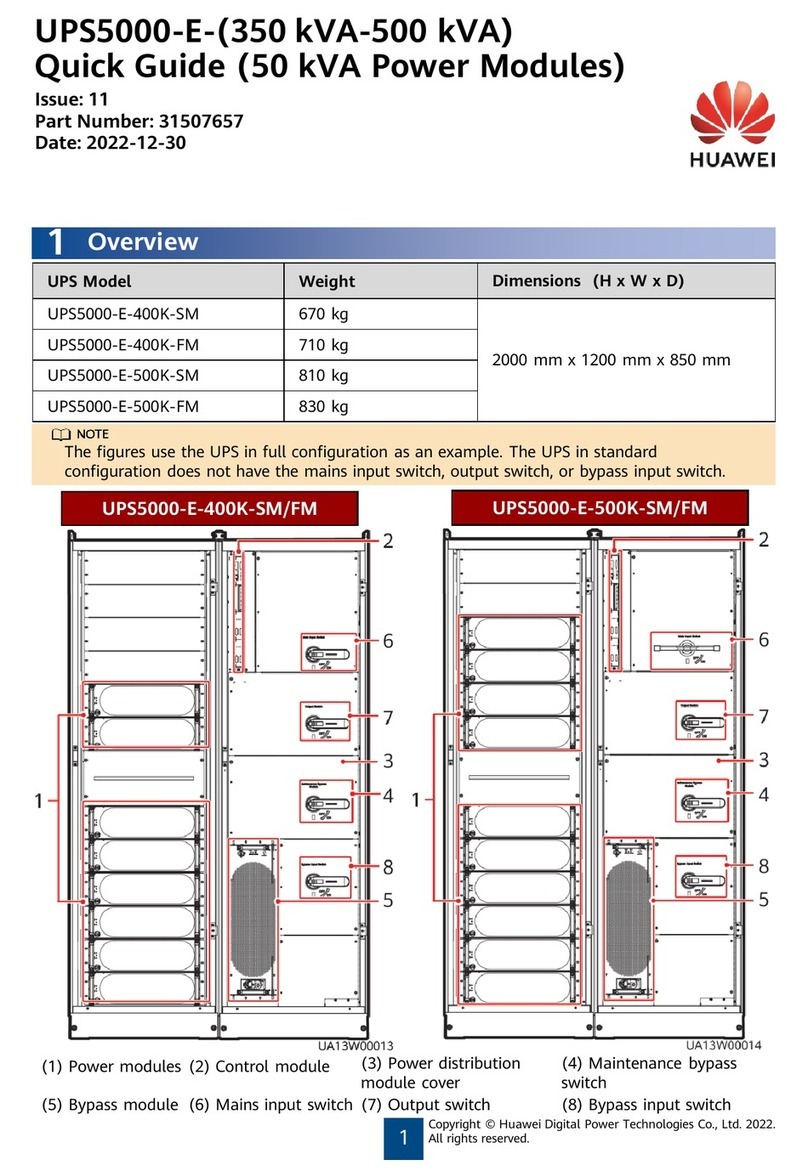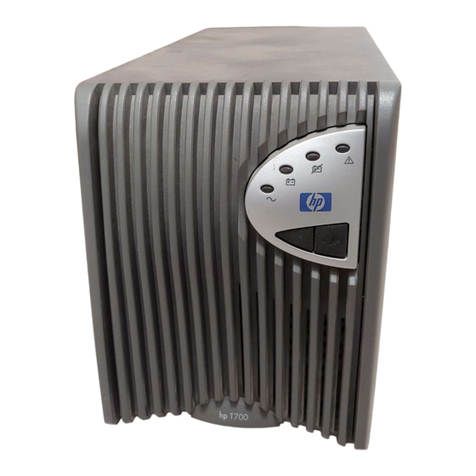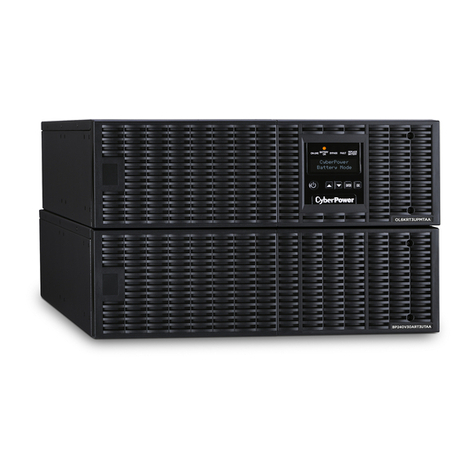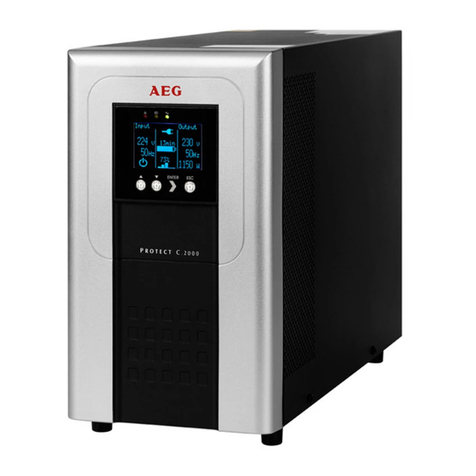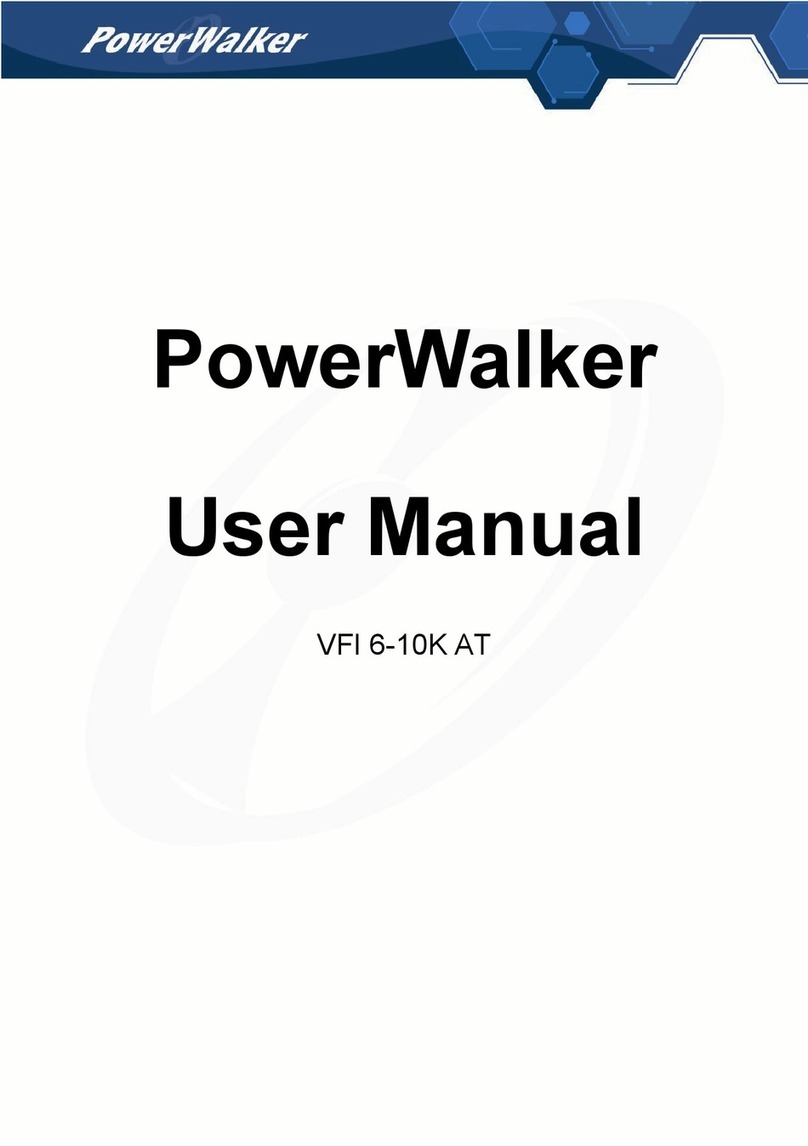nextys DCU20 User manual

DCU20 User Manual rev. 21
Page 1/29
DCU20
12/24V 20A High Performance DC-UPS
User Manual

DCU20 User Manual rev. 21
Page 2/29
DISCLAIMER
NEXTYS
reserves the right to make changes without further notice to any products herein.
NEXTYS
makes no warranty, representation or guarantee regarding the suitability of its products for any
particular purpose, nor does
NEXTYS
assume any liability arising out of the application or use of any
product, and specifically disclaims any and all liability, including without limitation consequential or
incidental damages. “Typical" parameters which may be provided in
NEXTYS
data sheets and/or
specifications can and do vary in different applications and actual performance may vary overtime. All
operating parameters, including “Typicals", must be validated for each customer application by
customer's technical experts.
NEXTYS
does not convey any license under its patent rights nor the
rights of others.
NEXTYS
products are not designed, intended, or authorized for use as components in
systems intended for surgical implant into the body, or other applications intended to support or
sustain life, or for any other application in which the failure of the
NEXTYS
product could create a
situation where personal injury or death may occur. Should Buyer purchase or use
NEXTYS
products
for any such unintended or unauthorized application, Buyer shall indemnity and hold
NEXTYS
and its
officers, employees, subsidiaries, affiliates, and distributors harmless against all claims, costs,
damages, and expenses, and reasonable attorney fees arising out of, directly or indirectly, any claim
of personal injury or death associated with such unintended or unauthorized use, even if such claim
alleges that
NEXTYS
was negligent regarding the design or manufacture of the part.
The Customer should ensure that it has the most up to date version of the document by contacting its
local
NEXTYS
office. This document supersedes any earlier documentation relating to the products
referred to herein. The information contained in this document is current at the date of publication. It
may subsequently be updated, revised or withdrawn.
The Customer should ensure that
NEXTYS
product uses the most up to date Software and Firmware
provided on
NEXTYS
website to ensure reliable operation of the system.
All Trade Marks recognized. Specifications and information herein are Subject to change without
notice.

DCU20 User Manual rev. 21
Page 3/29
TABLE OF CONTENTS
1System description...........................................................................................................................................5
2Features and benefits.......................................................................................................................................6
3Functional description ......................................................................................................................................7
3.1 Remote monitoring and controlling.............................................................................................................7
3.1.1 USB......................................................................................................................................................7
3.1.2 Digital input...........................................................................................................................................7
3.1.3 Dry contact outputs ..............................................................................................................................7
3.2 Backup........................................................................................................................................................8
3.3 PC shutdown and automatic restart ...........................................................................................................8
3.4 Battery health monitor...............................................................................................................................10
3.5 Battery resistance measurement..............................................................................................................11
3.6 Battery charger.........................................................................................................................................11
3.7 Coulomb counter ......................................................................................................................................12
3.8 Cold start ..................................................................................................................................................13
4Installation ......................................................................................................................................................14
4.1 Connecting the input to the power supply ................................................................................................14
4.2 Connecting the load..................................................................................................................................14
4.3 Connecting the battery .............................................................................................................................14
4.4 Connecting the temperature sensor .........................................................................................................14
4.5 Connecting the INHIBIT input...................................................................................................................15
4.6 Dry contacts..............................................................................................................................................15
4.7 Battery sense connection .........................................................................................................................15
5User interface.................................................................................................................................................16
5.1 Status........................................................................................................................................................17
5.2 Settings.....................................................................................................................................................17
5.2.1 Input nominal voltage.........................................................................................................................18
5.2.2 Battery chemistry ...............................................................................................................................18
5.2.3 Battery nominal voltage......................................................................................................................18
5.2.4 Battery capacity..................................................................................................................................18
5.2.5 Battery charge voltage .......................................................................................................................18
5.2.6 Battery charge current........................................................................................................................18
5.2.7 Battery deep discharge voltage .........................................................................................................18
5.2.8 Battery low voltage.............................................................................................................................19
5.2.9 Battery nominal internal resistance....................................................................................................19
5.2.10 Battery maximal internal resistance variation.................................................................................19
5.2.11 Battery maximum temperature .......................................................................................................19
5.2.12 Battery minimum temperature ........................................................................................................19
5.2.13 Battery lifetime................................................................................................................................19
5.2.14 Maximum backup time....................................................................................................................20
5.2.15 Inhibit polarity..................................................................................................................................20
5.2.16 Screen contrast...............................................................................................................................20
5.2.17 Screen backlight .............................................................................................................................20
5.2.18 Screen timeout................................................................................................................................20
5.2.19 Buzzer state....................................................................................................................................20
5.2.20 Lock settings...................................................................................................................................20
5.2.21 Date.................................................................................................................................................21
5.2.22 Time................................................................................................................................................21
5.2.23 PC shutdown enable.......................................................................................................................21
5.2.24 PC shutdown delay.........................................................................................................................21
5.2.25 PC shutdown time...........................................................................................................................21
5.2.26 PC restart minimum OFF time........................................................................................................21
5.2.27 PC OFF detection current threshold...............................................................................................21
5.2.28 PC OFF detection timer..................................................................................................................22
5.2.29 Relay 1 (Ready)..............................................................................................................................22
5.2.30 Relay 2 (Backup) ............................................................................................................................22
5.3 Info............................................................................................................................................................22
5.3.1 Firmware version................................................................................................................................22
5.3.2 Serial..................................................................................................................................................22

DCU20 User Manual rev. 21
Page 4/29
5.3.3 Name..................................................................................................................................................22
5.3.4 Power ON cycles counter...................................................................................................................22
5.3.5 Operating time....................................................................................................................................23
5.3.6 Battery installation date......................................................................................................................23
5.3.7 Battery operating time........................................................................................................................23
5.4 Logs..........................................................................................................................................................23
5.5 Wizard.......................................................................................................................................................23
6Events and Alarms .........................................................................................................................................24

DCU20 User Manual rev. 21
Page 5/29
1 System description
Use latest device Documentation, Software and Firmware to ensure reliable operation of
the system (downloadable from www.nextys.com).
The DCU20 is a microprocessor controlled DC UPS rated 20A (rating of the power supply
connectable to the input) usable in systems with a nominal voltage between 12V and 28V.
The DCU20 monitors the voltage coming from a DC power supply and in case of power failure a
backup battery is connected to the load. In normal condition the battery is kept charged by an
integrated battery charger supporting various battery chemistries such Lead-Acid, NiMH, NiCd and
Lithium.
1. Alarm LED indicator: It is ON when the
unit is in backup. It blinks at 1Hz rate in
case of error.
2. USB Port: Used to connect a PC running
the POWERMASTER application for remote
monitoring and controlling. Firmware
update is also possible through USB
connection.
3. Temperature sensor connection: Used to
connect a temperature sensor (P/N:
WNTC-2MT) to measure the battery
temperature for protection and
temperature compensated charge method.
4. Relays dry contacts: 2 relays are present
for remote monitoring. See §3.1 for more
details.
5. Inhibit input: A signal between 5VDC and
30VDC applied to this input inhibits the
backup function; this input is
programmable to be active high or active
low (see §4.5).
6. “Battery sense”connection: Used to
accurately sense the battery voltage by
considering the cables voltage drop. It is
recommended to use this input when the
battery internal resistance measurement is
needed (see §4.7).
7. Input connection: 2 poles are provided
for input connection. This must be
connected to a power supply rated
12…28VDC with a maximum rated current
of 20A (see §4.2).
8. Output connection: 2 poles are provided for output connection. It must be connected to the
load to be backed up with a maximum rated current of 20A (see §4.2).
9. Battery connection: 2 poles are provided for battery connection. This must be connected to
the battery. Although the unit is protected, please respect the correct polarity. (see §4.3)
10.Display “Input”area: provides information regarding the unit’s input (see §5.1).
11.Display “Output” area: provides information regarding the unit’s output (see §5.1).
12.Display “Battery”area: provides information regarding the battery (see §5.1).
13.Control keys: 4 push buttons are provided to navigate through the menus and to select the
various functions.
Figure 1: Front panel view

DCU20 User Manual rev. 21
Page 6/29
2 Features and benefits
The main features are:
Integrated battery charger for multi-chemistry batteries with charging current up to 5A.
Automatic sensing of input voltage, load current and battery current.
Protections against battery reverse polarity connection and over current when operating
from the battery.
Battery “health monitoring”system: measuring battery internal resistance, battery
temperature and providing a Coulomb counter.
User settable maximum backup time.
Remote input to inhibit the UPS function.
Connection of a battery thermal sensor (optional).
Integrated data logger with time stamp: all events / errors are logged in the internal memory
and downloadable through the USB interface.
Automatic PC shutdown/restart function (see §3.3)
Embedded user interface:
4 buttons and 1 color graphic CSTN LCD, Displays the set-up, status, measures and
alarms
Online device configuration.
USB port for remote monitoring and configuration.
Dry contacts for status monitoring
“POWERMASTER”PC application:
Connection through USB interface.
Remote monitoring and configuration.
Firmware upgrade.
Same functionalities of the embedded user interface with the ease of the PC benefits.

DCU20 User Manual rev. 21
Page 7/29
3 Functional description
A simplified block diagram of the DCU20 is shown in Figure 2.
1
1
2
2
3
3
4
4
5
5
6
6
7
7
8
8
D D
C C
B B
A A
DC-UPS_V0.1.SchDoc
Title
Size
Date
File
Document NumberRevision
Sheetof
Drawn By
DCU20 - 20A 12/24V DC-UPS Simplified Block Diagram
A3 doc_number V0.1
11
Marco Geri
11/07/2012
NEXTYS
V
A A
V
V
A
Reverse
Polarity
Battery health
Monitor
5A Battery
Charger
Microprocessor
Buttons Relays
USB
Thermal
Display
Buzzer
OUTIN
BATT
THR
USB
READY
BACKUP
Figure 2: DCU20 simplified block diagram
DCU20 is a high performance digitally controlled DC-UPS that can be used in any DC system with a
rated voltage between 12V and 28Vand up to 20A of input current.
It includes a battery charger capable of charging Lead-Acid, Ni-MH and Li-ION batteries with a rated
voltage between 12V and 28V and able to deliver a charge current up to 5A.
The input voltage is continuously monitored by the microprocessor. In case of a power outage the
battery is connected to the load instantaneously through an active switch, reducing the power loss to
a minimum.
The product offers additional features to improve the performance and the reliability of the system,
which are described below.
3.1 Remote monitoring and controlling
3.1.1 USB
The USB interface allows the communication with the proprietary POWERMASTER software (available
for download at www.nextys.com) which allows the full control and monitoring of the DCU20 unit with
the ease of the PC.
3.1.2 Digital input
An opto-isolated input allows the inhibition of the backup function. The polarity of the input can be
defined using the Inhibit polarity setting (see §5.2.15).
3.1.3 Dry contact outputs
2 relays are present on the DCU20. User can chose which event activates the relay and the polarity.
The list of events is the following:

DCU20 User Manual rev. 21
Page 8/29
Name
Description
Default setting
Backup
Active when the system is running on the
batteries.
Relay 2
SoC < 25% (Low Battery)
Active when the State of Charge (SoC) of the
battery is below 25%.
Unused
Battery life time expired
Active when the battery life time counter is
exceeding the value specified on §5.2.13
Relay 1
Battery Ri too high
Active when the measured battery internal
resistance (Ri)> alarm threshold. The threshold is
specified using setting §5.2.9 and §5.2.10.
Relay 1
Battery failure
Active when the battery could not be charged
correctly.
Relay 1
Battery under voltage
Active when the battery voltage is below the value
specified on §5.2.7
Unused
Battery backup time left < 25%
Active when the remaining backup time is higher
than the 75% of the maximal backup time defined
on §5.2.14
Unused
PC OFF signal
Activated by the PC shutdown and automatic
restart function. See §3.3 for details.
Unused
Table 1: Relays signals
By default both relays polarity is set to NC (Normal Close).
3.2 Backup
The system is in backup if the supply for the output is sourced from the battery (input supply missing).
During backup the battery is monitored continuously to prevent over discharge (see §5.2.7).
A programmable backup timer (see §5.2.14) is also implemented in order to fix a maximum backup
time during power outages. This allows preserving the battery life and shortening the recharge time,
avoiding discharging the battery when not needed.
During backup the internal Coulomb counter is used to give an estimation of the residual charge of
the battery, this information is given to the user on the LCD in form of remaining % and through the
ready relay which starts toggling at 1Hz once the battery charge is < 20%.
3.3 PC shutdown and automatic restart
PC shutdown: In case the DCU20 is used to supply a PC it is possible to automatically shut down
the PC after an adjustable time of backup. For this the PC must run the POWERMASTER application
(provided free) and must be connected through USB. Optionally POWERMASTER can call a task on
the PC before shutting down, for example to backup some sensitive data.
Automatic restart: DCU20 is able to automatically restart a PC which was powered OFF by mistake,
for example in case of the Operating System (OS) crash. The user may adjust an output current
threshold and a timer used for detecting the PC OFF status. In order to restart the PC the DCU20
toggles the output OFF and then ON again. User must enable in the PC BIOS the automatic start in
case of supply ON.
Note: The DCU20 cannot interrupt the supply flow from the input to the output. Therefore the user
must use one of the DCU20 available relays (by activating the PC OFF signal on it) in order to enable
automatic PC restart when the input supply is present. The relay contact (rated 2A/30Vdc) must be
wired in series to the device output using a 4A fast cartridge fuse (Littlefuse 0217004.HXP or
equivalent). Be careful to respect maximum current rating of the fuse.

DCU20 User Manual rev. 21
Page 9/29
In case the load (PC) current exceeds the DCU20 dry contact rating the use of an external relay with
suitable current/voltage rating is needed, relay coil voltage shall match output voltage. It should be
driven by the DCU20 internal dry contact.
Figure 3: Internal relay
Figure 4: External relay
The diagram below shows the DCU20 behavior when Shutdown and automatic restart is enabled.
Time
PC OFF signal
PC status
Output voltage
Output current
Input voltage
T1 T2 T3
... ... T4 T3
E3
E1
E2
E4
Ioff
Figure 5: Shutdown and restart chart
Parameter
Name
Description
E1
Backup
Power failure on the line happens. System enters backup mode.
E2
Automatic PC
shutdown
The POWERMASTER sends a shutdown command to the PC.
Optionally: a task is called before shutdown.
This event is triggered by the “PC shutdown delay”(§5.2.24) or
“Battery low alarm”(§5.2.8), whatever comes first.
E3
Unexpected PC
shutdown
The PC shutdowns in an unexpected way, for example caused by
OS crash.
E4
PC restart
DCU20 detect the PC being OFF because the output current was

DCU20 User Manual rev. 21
Page 10/29
lower than Ioff current threshold for T4 time. As a consequence
DCU20 generates an ON->OFF->ON cycle on its output.
T1
PC shutdown delay
User settable (§5.2.24). Time between start of backup and start of
PC shutdown procedure.
T2
PC shutdown time
User settable (§5.2.25). Time between start of shutdown
procedure and output voltage OFF. This time must be set longer
than the maximum time the PC takes to complete the shutdown.
T3
PC restart minimum
OFF time
User settable (§5.2.26). T3 is the delay used between the return
of the input voltage and the activation of the output. The same
time is used by the automatic restart function as power OFF time
to restart the PC. The value must be big enough for the PC to
detect the supply ON->OFF->ON cycle to restart.
T4
PC OFF detection
timer
User settable (§5.2.28). Minimum time at which the output current
must be below the Ioff current threshold to trigger the automatic
PC restart (PC supply ON->OFF->ON cycle).
Ioff
PC OFF detection
current threshold
User settable (§5.2.27). Current threshold used to detect PC OFF
status. This value must be lower than the minimum PC current
consumption when this is ON.
Table 2: Shutdown and restart
The parameters are settable through the DCU20 LCD or using the POWERMASTER application as
shown on the image below. The checkbox “Run on startup” must be checked on POWERMASTER
when PC shutdown function is used, select “Start in tray” to start in minimized into the windows
system tray. To inhibit the software from calling the shutdown command user can select the “Inhibit
shutdown” check box.
Figure 6: PC shutdown settings
3.4 Battery health monitor
The battery health monitor is composed of:
Internal resistance (Ri) measurement: The resistance is periodically measured. The
internal resistance is a good indicator of the battery health status; a sudden increase of the
internal resistance indicates a potential problem on the battery or on the battery wiring (see
§3.5).

DCU20 User Manual rev. 21
Page 11/29
Temperature (T) measurement: The battery temperature is monitored through an optional
temperature sensor (P/N: WNTC-2MT). The battery charger takes into account the battery
temperature and provides a temperature compensated charging voltage. In case of over
temperature the system disconnects the battery to prevent damage.
Coulomb counter: It allows having a quick estimation of the remaining battery capacity
and consequently the available backup time.
Deep discharge protection: It protects against the deep discharge of the battery which
can lead to its irreversible damage.
3.5 Battery resistance measurement
The battery internal resistance (Ri) is measured by injecting a defined AC current through a constant
current source (CCS) in the battery and measuring the AC voltage drop across the battery terminals.
The principle is represented in Figure 7.
The injected AC current I(AC) is flowing also through the cables + connectors resistance - “Rcables”.
Ri
+-
Battery
Rcables
Constant
Current
Source
(CCS)
I(AC)
Figure 7: Internal resistance measurement
Without using the battery sense connection as shown in Figure 9 the AC voltage drop is
measured across the battery connection terminals on the DCU20. The measured resistance will be in
this case:
Rmeasured=Ri+Rcables. When high Ah batteries and / or small and long cables are used Rcables
can be > Ri. Anyhow a connection problem as for example a loose contact can be detected by this
measurement method.
By using the battery sense connection (a “Kelvin” type connection) as shown in Figure 10 the
AC voltage drop is measured directly at the battery terminal. In this case the measured resistance is
exactly the battery internal resistance Ri, independently on the cables length and size.
It is recommended to use this method to have an accurate reading of the battery internal resistance
and thus an accurate prediction of the battery health status.
If the battery sense cables length is > 2m it is recommended to twist the 2 wires together in order to
increase the noise immunity.
3.6 Battery charger
The battery charger supports various chemistries such Lead-Acid, Nickel, Lithium and every other
battery chemistry assuming that the charging voltage and charging current values are provided by the
battery manufacturer. The charging algorithm is shown on Figure 8. Other charging algorithms can be
implemented by request.
The user must set to the unit the following parameters to allow the charger to perform correctly:
Battery chemistry: selectable between Lead-Acid, Nickel, Lithium (see §5.2.2).
Battery nominal voltage: between 12V and 28V (see §5.2.3).

DCU20 User Manual rev. 21
Page 12/29
Battery capacity: between 1.2Ah and 150Ah (see §5.2.4).
Battery charging voltage: provided by the battery manufacturer (see §5.2.5).
Battery charging current: provided by the battery manufacturer (see §5.2.6).
Battery deep discharge voltage (see §5.2.7).
The battery charger automatically reduces the current to avoid exceeding the maximum input current
(20A) in case of high current load. For example if the load is consuming 19A and the charger current
is set to 3A, the charger current is automatically reduced to 1A to avoid the 20A input current limit.
The charger voltage is independent on the input voltage (power supply), and is user settable.
Time
Current
Voltage
Constant current Constant voltage Maintenance
User settable charge
User settable charge
voltage
current
Figure 8: Battery charging algorithm
The battery charge terminates in case at least one of the following conditions are satisfied:
Low current: The measured battery current is lower than 10% of the “Battery charge
current”.
Timer: the charge is terminated after the battery has been charged for a predetermined
amount of time. The value is automatically calculated by the device.
For Nickel batteries only the following conditions are also checked:
Temperature Cutoff (TCO): The battery temperature if higher than the “Battery maximal
temperature”(§5.2.11) minus 3°C for more than one minute. For example if the maximal
battery temperature is set to 60°C, the charge terminates in case the temperature is higher
than 57°C.
Rate of Temperature Increase (ΔT/dt): The battery temperature is rising at a rate equal or
superior then 1°C/min. To avoid unattended end of charge don’t place the system on an
ambient with rapid changes of temperature (for example exposed to direct sunlight).
Warning: In order to avoid potentially hazardous situations including fire hazard, safety
recommendations must be followed. Only authorized staff can install the unit.
Warning: For Lithium cells the balancing and protection circuit must be included in the
battery pack.
For nickel batteries the use of the external temperature sensor is mandatory. The sensor
must be placed in contact with the battery.
3.7 Coulomb counter
DCU20 measures the current flowing from/to the battery to keep track of the capacity available on the
battery. The capacity is measured in Ampère Hours [Ah]. The value shown is based on the following
assumptions:

DCU20 User Manual rev. 21
Page 13/29
The value shown is just informative and does not represent the real state of charge of the
battery in some circumstances, for example if the battery is damaged.
When the battery is connected for the first time or the system starts from OFF, the system
assumes the battery is fully discharged and start with 0Ah counter.
For Lead acid batteries only, during battery charge an approximation of charge is done
checking the battery voltage.
Once the battery is fully charged the system sets the counter to the nominal capacity
specified by the user (§5.2.4).
3.8 Cold start
The cold start is a procedure that allows turning ON the UPS without the input power. This procedure
is used to turn ON the UPS to operate during a power interruption or to determine if the UPS will not
turn ON due to a bad input power. This practice is also a method to see if the battery connected to the
DCU20 is functional.
In cold start the DCU 20 will remain ON for at least 60 seconds independently from the battery voltage
being under the deep discharge threshold, the inhibit input and the backup timer.
After the first 60 seconds the device stays ON until the battery is not deep discharged, the “Max
backup timer” is not expired or the inhibit input is not active.
If the input supply returns during cold start the device reverts to normal operation.
To cold start the DCU20:
Press and HOLD simultaneously the menu button and OK button until you see the
welcome message on the screen. On the status screen the input voltage status is indicated
as “COLDSTART”.
RELEASE the buttons.

DCU20 User Manual rev. 21
Page 14/29
4 Installation
Warning: In order to avoid potentially hazardous situations including fire hazard, safety
recommendations must be followed. Only authorized staff can install the unit.
4.1 Connecting the input to the power supply
The DCU20 must be connected to a DC power supply rated between 12VDC and 28VDC with a
maximum output current of 20A. Use only 60/75 Class I copper 1.5…2.5mm2wires stripped
6...7.5mm. The tightening torque must be 0.5…0.6Nm.
Please respect the wiring polarity!
Note: The input current is equal to the load current plus the current needed by the battery charger to
recharge the battery.
Caution: This input is designed to be connected ONLY to a short circuit protected power
supply; connecting a battery to this input or other DC sources with not defined current
limitation may seriously damage the unit or the load and even result in fire hazard.
4.2 Connecting the load
The DCU20 must be connected to a DC load rated between 12VDC and 28VDC / maximum 20A. Use
only 60/75 Class I copper 1.5…2.5mm2wires stripped 6...7.5mm. The tightening torque must be
0.5…0.6Nm.
Please respect the wiring polarity! Please check the load and the power supply are rating compliant.
4.3 Connecting the battery
The DCU20 must be connected to a battery with nominal voltage between 12VDC and 28VDC with up
to 150Ah capacity. Higher capacity batteries can also be used at the expense of a longer charging
time. Use only 60/75 Class I copper 1.5…2.5mm2wires stripped 6...7.5mm. The tightening torque
must be 0.5…0.6Nm.
Caution: The battery shall be connected to the DCU20 through a 30A ATO fuse (or
equivalent). Even is the unit is electronically protected against short circuit it is mandatory to
use a fuse for safety reasons.
Please respect the wiring polarity!
Avoid keeping the DCU20 connected to the battery for long time when not used. Although the current
consumption from the battery when the unit is OFF is very low (about 30µA) it can discharge the
battery in the long time.
4.4 Connecting the temperature sensor
An optional temperature sensor (P/N: WNTC-2MT) can be connected to its input on the front panel.
The temperature sensor is provided with 2m long cables and must be fixed to the battery body to
measure its temperature (an adhesive pad can be used). When the sensor is connected the battery
temperature is automatically displayed on the LCD and a temperature compensated charge is
activated when charging Lead-Acid batteries.

DCU20 User Manual rev. 21
Page 15/29
4.5 Connecting the INHIBIT input
An opto-isolated digital input is provided. A digital signal between 5VDC and 30VDC must be applied
to this input to enable the INHIBIT function. By default when the signal is 0V (or the INHIBIT input is
not connected) the unit will switch the load to the battery as soon as the input voltage is no more
present. Applying a signal to this input inhibits the backup function and the load can be switched OFF
as soon at the input fails with no battery backup. The polarity of this input can be changed as
explained in §5.2.15.
4.6 Dry contacts
2 relays’dry contacts are provided on the DCU20. Connect the 2 relays dry contact using 60/75 Class
I copper 0.15…0.5mm2wires stripped 7...8mm. The connector is provided with spring terminals.
Note: the 2 relays contacts have one pole in common.
4.7 Battery sense connection
Figure 9: Battery connection without sense
Figure 10: Battery connection with sense
The battery sense connection is optional and it is recommended to use it to have an accurate
measurement of the battery internal resistance (see §3.5).
Caution: please respect the polarity of the battery sense connection!

DCU20 User Manual rev. 21
Page 16/29
5 User interface
Power ON screen:
This screen is shown at power ON. It shows the
device name, serial number and firmware version.
Status:
This is the default view where the user can find the
most relevant information about the device status.
The system always falls back to this view after 60s
of inactivity (no key pressed).
Settings:
All the device settings are configurable from this
menu. Use the UP/DOWN KEY to navigate through
the parameters. Press the OK KEY to enter/exit the
editing mode. In editing mode use the UP/DOWN
KEY to change the highlighted value.
Info:
Device information such as firmware version, serial
number and device name is visible from this menu.
Logs:
All the alarms and event are logged in a circular
buffer and visible from this screen. Use the
UP/DOWN KEY to navigate through the logs.
Wizard:
The wizard helps the user to configure the system
through a series of screens.
Table 3: User interface layout

DCU20 User Manual rev. 21
Page 17/29
Symbol
Name
Function
MENU KEY
Scrolls between menus.
DOWN KEY
Scrolls down menus and values.
UP KEY
Scrolls up menus and values.
OK KEY
Confirms selection.
Table 4: User interface keys
The GUI is composed of 5 main menus which are selectable using the MENU KEY as shown on
Table 3. The description of each menu is given below.
5.1 Status
The status screen shows the measurement and statuses to ease the system diagnostic. The screen is
divided in three main sections identified by the symbols shown below:
Input: The measured input voltage and current is shown in this section. In case of problems
with the input the background color of the symbol changes from green to red. A message
with the cause appears.
Output: The measured output voltage and current is shown in this section. In case of
problems with the output the background color of the symbol changes from green to red and
a message with the cause appears.
Battery: The battery voltage, current, temperature, resistance and charge are shown in this
section. In case of problems with the battery the background color of the symbol changes
from green to red and a message with the cause appears. During charging and discharging
the symbol background color changes to orange and the number of bars drawn inside
reflects the charge status. During discharging and charging an arrow drawn beside the
symbol reflects the direction of the current flowing through the battery, pointing towards the
battery during charging.
Table 5: Status screen symbols
Furthermore in case of problem a full screen alarm message appears on the screen
after 1min of inactivity (no key pressed). The message can be removed pressing the
MENU KEY.
5.2 Settings
The setting menu contains all the configurable parameters available to the user. Use the UP/DOWN
KEY to navigate through the menu items. Press the OK KEY to enter and exit the editing mode, while
in editing mode use the UP/DOWN KEY to change the selected value.

DCU20 User Manual rev. 21
Page 18/29
5.2.1 Input nominal voltage
Used to set the nominal input voltage on the input connector. Used to generate the
input under voltage and over voltage alarm. See §6 for more details.
Default: 24V
Range: 11V …28V
Resolution: 0.1V
5.2.2 Battery chemistry
Used to set the chemistry of the battery. The system support Lead Acid, Nickel and
Lithium batteries. For Lithium the battery pack used must include the protection and
balancing circuitry.
Default: Pb
Choices: Pb, NiMh (CC/CV), Lith.(CC/CV)
5.2.3 Battery nominal voltage
Used to set the nominal battery voltage.
Default: 24V
Range: 11V … 28V or input nominal voltage +20%
Resolution: 0.1V
5.2.4 Battery capacity
Used to set the nominal battery capacity of the battery. The internal Coulomb
counter uses this value to indicate the state of charge of the battery.
Default: 2Ah
Range: 1.2Ah … 150Ah
Resolution: 0.1Ah
5.2.5 Battery charge voltage
Used to set the maximum voltage used to charge the battery. See §3.6 for more
details.
Default: 28.8V
Range: battery nominal voltage … 33V or battery nominal voltage +40%
Resolution: 0.1V
5.2.6 Battery charge current
Used to set the maximum current used to charge the battery. See §3.6 for more
details.
Default: 0.2A
Range: 0.2A … 5A
Resolution: 0.1A
5.2.7 Battery deep discharge voltage
Used to set the deep discharge voltage of the battery. If the measured battery
voltage drops below this value the system disconnects it in order to prevent
irreversible damage.
Default: 18V
Range: 8.2V … battery nominal voltage -25%
Resolution: 0.1V

DCU20 User Manual rev. 21
Page 19/29
5.2.8 Battery low voltage
An alarm is generated if during discharge the battery voltage drops below this
threshold.
Default: 18V
Range: battery deep discharge voltage … 28V
Resolution: 0.1V
5.2.9 Battery nominal internal resistance
Used to set the nominal battery internal resistance of the battery. When set to
automatic the system will record the next valid measurement as the nominal value.
When set to disabled no alarm related to the battery internal resistance will be
generated.
Default: Disabled
Range: 1mΩ… 300mΩ, Disabled, Automatic
Resolution: 1mΩ
5.2.10 Battery maximal internal resistance variation
Combined with the nominal internal resistance, it defines the threshold for the
ALARM_BATTERY_RI_TOO_HIGH.
Default: 200%
Range: 20% … 300%
Resolution: 1%
5.2.11 Battery maximum temperature
An optional external temperature sensor (P/N: WNTC-2MT) is required. Used to set
the maximum temperature at which the battery can operate safely. If the measured
temperature exceeds the set value, an alarm is generated and the battery charging
is stopped until the return under normal temperature level.
Default: 50°C
Range: 30°C … 80°C
Resolution: 1°C
5.2.12 Battery minimum temperature
An optional external temperature sensor (P/N: WNTC-2MT) is required. Used to set
the minimum temperature at which the battery can operate safely. If the measured
temperature is lower than the set value, an alarm is generated and the battery
charging is stopped until the return under normal temperature level.
Default: -10°C
Range: -20°C … 0°C
Resolution: 1°C
5.2.13 Battery lifetime
Used to set the expected battery lifetime. Once the battery operating time exceeds
the set value an alarm is generated.
Default: 100kh
Range: 1kh … 200kh
Resolution: 1kh

DCU20 User Manual rev. 21
Page 20/29
5.2.14 Maximum backup time
Used to set the maximum time the system stays in backup before switching OFF. If
disabled the system stays in backup until the battery reaches the deep discharge
voltage.
Default: 2h
Range: 10s … 2h, No timeout
Resolution: 1s
5.2.15 Inhibit polarity
Used to select the polarity of the INHIBIT input. The inhibit input prevents the system
to enter the backup mode.
Default: High
Choices: Low, High
5.2.16 Screen contrast
Used to set the LCD screen contrast.
Default: 24
Range: 0 … 40
Resolution: 1
5.2.17 Screen backlight
Used to set the LCD screen backlight.
Default: 2
Range: 1… 10
Resolution: 1
5.2.18 Screen timeout
To save the LCD backlight the system dims the LCD after the defined timeout value.
Default:5min
Range: 1min … 30min, Disabled
Resolution: 1min
5.2.19 Buzzer state
Used to enable or disable the internal acoustic alarm buzzer.
Default: Enabled
Choices: Enabled, Disabled
5.2.20 Lock settings
Used to lock the devices settings editing in order to avoid unintentional changes.
When enabled any attempt to change parameters will show a “Settings Locked”
followed by the current parameter value. Keeping pressed at the same time for at
least 3 seconds the up and down button while on “SETTINGS”menu toggles the
Lock settings value.
Default: Disabled
Choices: Enabled, Disabled
Other manuals for DCU20
1
Table of contents
Other nextys UPS manuals
Popular UPS manuals by other brands

Huawei
Huawei UPS5000 user manual
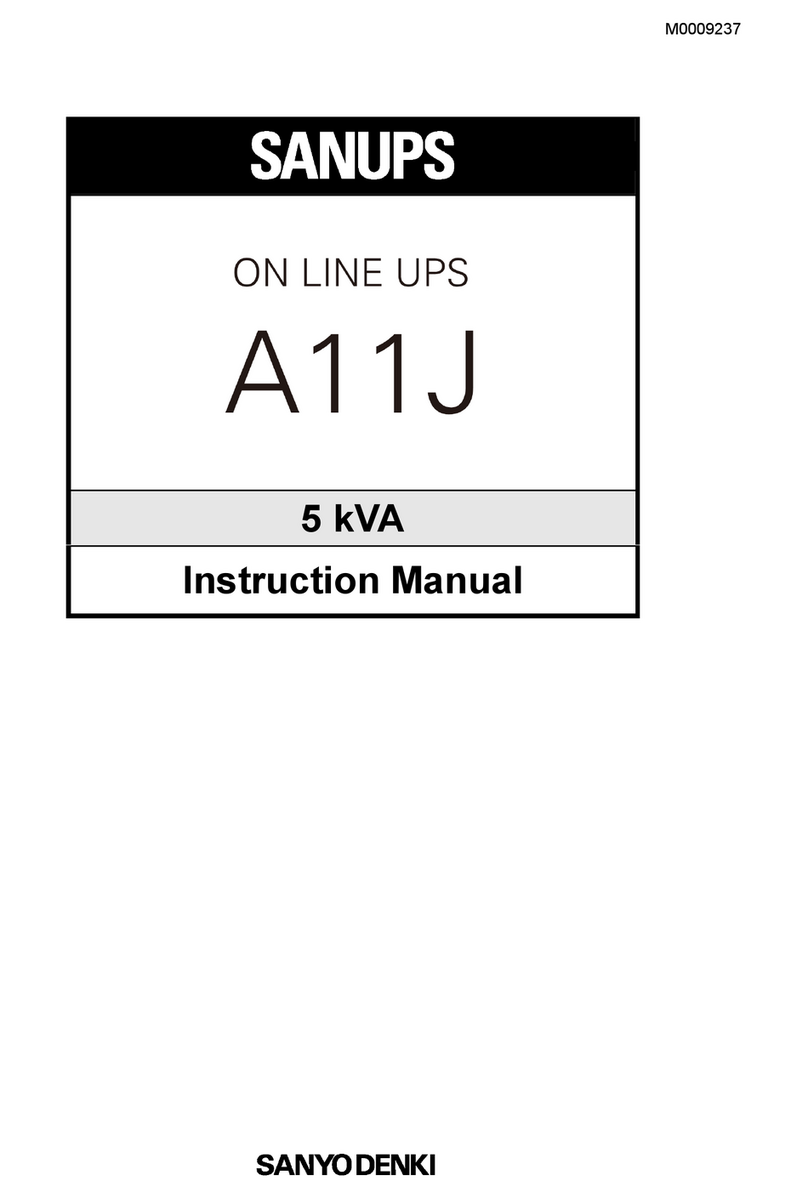
Sanyo
Sanyo SANUPS A11J instruction manual

Mitsubishi
Mitsubishi 7011A SERIES Owner technical manual
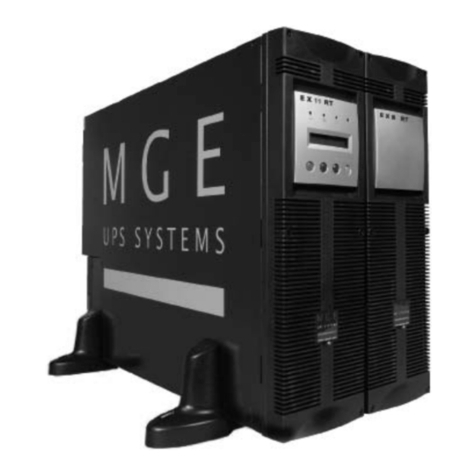
MGE UPS Systems
MGE UPS Systems EX 11RT Installation and user manual

Power Inspired
Power Inspired VIX2060 user manual

Eaton
Eaton Powerware 9390 Installation and operation manual
